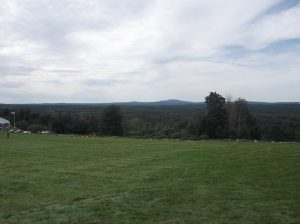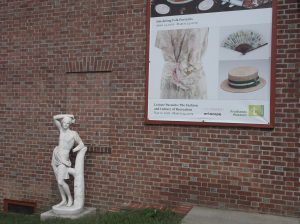The Smithsonian Institution once again sponsored Museum Day this September, and I went along for the ride. Although I had been there before, and as a member of the Trustees of Reservations can visit the property at any time at no charge, I chose to visit Fruitlands Museum in Harvard, On this, the last day of summer, we felt the chill of autumn, but the sun kept peeking through the clouds, and I think that most of us who were out and about today were struck by the beauty of the surroundings. This is the view one sees upon arrival:

The museum consists of four buildings, and I visited each in turn. First was the art museum:

I walked quickly through two of the exhibits, Inhabiting Folk Portraits: 12 Portraits with Candice Smith Corby, and A New View: Landscapes from the Permanent Collection, but spent more time in Leisure Pursuits: The Fashion and Culture of Recreation; the Trustees’ website explains
Visitors will see original antique and vintage dresses and personal accessories that were integrated into activities such as gardening, entertaining, fitness, water activities, equestrian pursuits, and travel at and to various properties.
Next I visited the Native American collection; this sculpture stands outside the building:

Before I continue, I should say a few words about the museum as a whole: it was founded by the visionary and hardworking Clara Endicott Sears (1863-1960), a New England author, preservationist, and philanthropist. In 1910, she purchased a summer estate in Harvard, which included the farmhouse known as Fruitlands, the famous nineteenth communitarian experiment. She restored the building, collected numerous materials, and opened the museum in 1914. In subsequent years, she added to the property by incorporating Shaker collections, Native American collections, and American folk art and Hudson River School paintings.
The Native American Museum collection is not extensive, but the pieces were carefully chosen, and the curators present the displays from an anthropological perspective and from the point of view of the Native peoples, rather than from a colonialist viewpoint. Here are my favorite pieces:
This is a bear claw necklace from one of the Plains tribes:

This piece is from the Pacific Northwest; it’s called Crooked Beak Cannibal Bird Headdress:

Outside the museum building is a replica of a longhouse as built by a Northeast Woodland tribe:

I went on to the Fruitlands Farmhouse itself. The story of this failed experiment is well-known: for about seven months in 1843, Bronson Alcott and Charles Lane led a group of idealistic New Englanders in a life that was intended not to cause harm to others. Here in this valley near the Nashoba RIver, with a handful of other followers, they tried to live a self-sufficient life, eating their own produce and wearing homemade linen clothes. The utopian experiment failed for a number of reasons: tension between the founders, lack of farming expertise, unrealistic expectations. Basically, with their self-imposed restrictions (they did not use animals to plow the fields or animal manure for fertilizer), they could not grow enough food to feed themselves.
Like thousands of young girls all over the world, I loved Little Women and was excited to see the very attic where young Louisa May Alcott lived with her family. The Museum has on display some of the objects that belonged to the Alcott family:

I was also fascinated by pencils manufactured by Henry David Thoreau’s company:

The Shaker Museum was the fourth building I visited:

It was the first Shaker museum to be established in this country and is home to the largest archive of Harvard Shaker documents in the world, housed in a historic building moved here from the Harvard Shaker community itself. The Shakers were the most successful utopian community in America. A religious sect founded in England in the eighteenth century, this group practiced a celibate and communal lifestyle, pacifism, and equality of the sexes. Early in the nineteenth century in the US, there were over twenty established Shaker villages along the East Coast, from Maine to Florida. In the period between 1820 and 1860, the Shakers thrived: communities expanded from New England to the Midwestern states of Indiana, Kentucky and Ohio. Hard-working and innovative, Shakers became known for their furniture design and craftsmanship. Here in Central Massachusetts, the Shirley Shakers specialized in the sale of seeds, while the Harvard Shakers specialized in herbs.
Perhaps our continuing fascination with the Shakers has something to do with their celibate lifestyle. We wonder, “How did they survive? Why would people join them?” I think the answer lies in their ideals of radical egalitarianism, which in turn was based on their conception of God and their understanding of what God expected of believers. In an era when there were no social services as we know them today, the Shakers took in social outcasts and treated them fairly. They welcomed all, often taking in orphans and the homeless, and educating them for trades. If you were willing to work, in a Shaker community you would be safe from starvation and abuse; you would have a roof over your head and food on the table. With the acceleration of social change after the Civil War, these kinds of benefits began to be provided by local governments and charitable organizations, and the decline of the Shakers began and has not stopped.
Fruitlands Museum has also developed an extensive trail system on its 210 acres of forest, wetlands, and meadows. The trail map I picked at up the information desk listed the Yellow Loop, White Loop, Blue Trail, Orange Loop, and the Red Loop. I decided to try the Yellow Loop, which leads to the Willard Farm Site, which has a self-guided tour of a Yankee farm (c. 1750-1852) based on historical research and several archaeological digs. I was impressed by the work carried out by the archaeologists — in the absence of extensive documentation we take for granted in this digital age, they had to pore over land records and examine soils in order to figure out how a farm family lived two hundreds years ago at this site. It looks like woods now, as in the photo below, but this area used to be a thriving farm:
